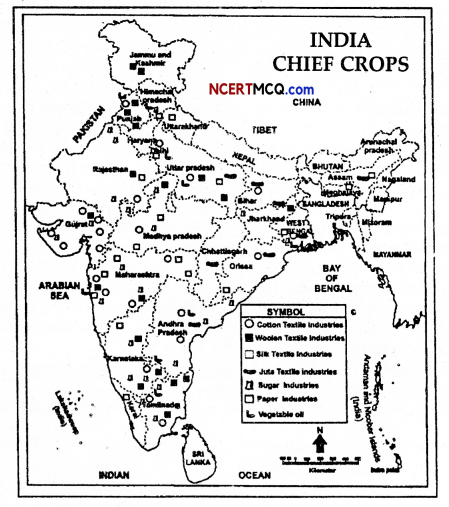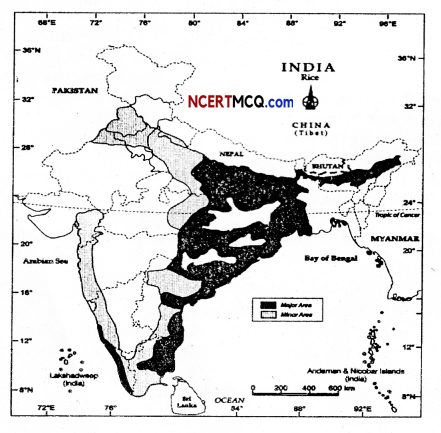Check the below NCERT MCQ Questions for Class 10 Geography Chapter 4 Extra Questions and Answers Agriculture Pdf free download. https://ncertmcq.com/extra-questions-for-class-10-social-science/
Agriculture Class 10 Extra Questions Geography Chapter 4
Agriculture Class 10 Extra Questions Question 1.
Name the country which is the largest producer of rice in the world.
Answer:
China.
Class 10 Geography Chapter 4 Agriculture Extra Questions Question 2.
Which country is the second-largest producer of rice in the world?
Answer:
India.
Agriculture Extra Questions Class 10 Question 3.
How many crops seasons are there in India?
Answer:
Three: Rabi, Kharif, Zaid.
Class 10 Agriculture Extra Questions Question 4.
What is til known as?
Answer:
Sesamum.
Class 10 Geography Chapter 4 Extra Questions Question 5.
Which crop is sesamum?
Answer:
Kharif.
![]()
Extra Questions Of Agriculture Class 10 Question 6.
How many days does cotton requires to grow?
Answer:
At least 210 frost-free days in a year.
Agriculture Class 10 1 Mark Questions Question 7.
Name the crop which China produces the largest in the world.
Answer:
Cotton.
Agriculture Class 10 Extra Questions And Answers Question 8.
Name there largest producing cotton countries in the world.
Answer:
China, USA and India.
Extra Questions On Agriculture Class 10 Question 9.
Name any two beverage crops of India.
Answer:
Tea and Coffee.
Class 10 Geography Chapter 4 Extra Question Answer Question 10.
Name a classic example of plantation agriculture.
Answer:
Tea cultivation.
Extra Questions For Class 10 Geography Chapter 4 Question 11.
Point out the features of the Green Revolution.
Answer:
- Green Revolution is actually a phrase used to describe the spectacular increase in the production of foodgrains in India.
- The green revolution has been caused by large-scale use of high yielding variety of seeds and the development of surface and groundwater irrigation.
- Large scale use of fertilizers, insecticides, and pesticides, land reforms, rural electrification and farm mechanisation has held green revolution.
![]()
Agriculture Class 10 Important Questions Question 12.
Point out the reasons for which rice cultivation is spreading northward and wheat cultivation shifting westward and to central India.
Or
Wheat and rice cultivation are changing their place. Do you agree?
Or
Rice cultivation is spreading northward and wheat cultivation is shifting westward end to central India. Give reasons.
Answer:
Rice requires hot and humid climate as well as a lot of water. This made it difficult to cultivate rice in Punjab and Haryana earlier. But the developed irrigational facilities in these states has done wonders and thirst of water has been provided by irrigation. The farmers of these states are very industrious too. They have really done wonders with their mechanized implements.
It is the main reason that the rice cultivation is spreading northward. The wheat cultivation is also shifting westwards end to central India. The main reason behind this development lies in the development of new varieties of hybrid seeds which flourish in areas of less rainfall of the western states and central India like Rajasthan, Gujarat, Maharashtra Madhya Pradesh etc.
Class 10 Geography Chapter 4 One Mark Questions Question 13.
Write a short note on the pulse production.
Answer:
India is the largest producer and consumer of pulses. They are the major source of proteins in our vegetarian diet. Major pulses are tur which is also known as arhar, urad, moong, masur, peas and gram. Arhar, urad and moong are the Kharif crops while Masur, peas and gram are rabi crops.
Pulses are grown all over the country except in the areas of heavy rain. Plants of pulses also helps in restoring fertility of the soil and hence they are grown in rotation with other crops. Madhya Pradesh, Uttar Pradesh and Rajasthan are the major gram producing states. Other important producers are Maharashtra and Karnataka. Tur is produced primarily in Maharashtra, Uttar Pradesh, Karnataka, Madhya Pradesh and Andhra Pradesh.
Agriculture Class 10 Questions And Answers Question 14.
Give reasons why as to the production of pulses and oilseeds are still lagging far behind.
Answer:
India produces pulses in a very large quantity but its consumption is also very high. Oilseeds are also one of the most important parts of our food. Hence the demand for oilseeds and pulses are not only very high but also increasing day by day. It is the main reason that we are still lagging behind in the production of these two commodities.
Class 10 Geography Chapter 4 Important Questions Question 15.
Give the reason as why to the extension of green revolution is necessary in India?
Answer:
Though we have succeeded in growing foodgrains in a large quantity, yet our population is doubling nearly after every 35 years. Because of this fact we need more and more food for our expanding population. For this green revolution must be expanded to the other parts of the country.
Hence we must speed up our production. For the promotion of our industry, we would be requiring more and more of raw materials which mostly come from agriculture. Green revolution in fact symbolises prosperity. Hence if we want that all of the parts of India should prosper we should expand Green Revolution to all parts of India.
![]()
Class 10 Geography Chapter 4 Extra Questions And Answers Question 16.
What is the Operation Flood? Why it should be expanded to all over the country?
Answer:
It is absolutely necessary to expand white Revolution in the country. The main reasons behind this necessity are the following-
- Dairy development is greatly needed in all over India for the supply of milk and milk products.
- Dairy development will no doubt lead to the development of rural areas,
- It will supplement the meagre income of the small and marginal farmers.
- It will also provide farm manure and biogas.
- It will in fact go a long way in removing poverty in the rural areas.
White Revolution is popularly known as the Operation Flood. Various technological and institutional reforms have contributed a lot to the White Revolution in our country. The dairy cooperatives play an important role in collecting and marketing milk.
The dairy cooperatives have been formed in different parts of the country for the collection and better distribution of milk. The dairy cooperatives in Gujarat supply milk, butter, cheese etc. to various parts of the country. National Milk Food is the major achievement of Operation Flood. Because of it help equable collection and distribution of milk in the country has reached an inspiring high. It made India first in the production of milk worldwide.
Chapter 4 Geography Class 10 Extra Questions Question 17.
Describe various technological and institutional reforms, which led to green and white revolutions in India.
Answer:
Green revolution has turned India independent in the production of foodgrains while white revolution has made it the longest producer of milk in the world. Various technological and institutional reforms have been adopted to bring about green revolution and white revolution in India.
Green Revolution-
- To bring this revolution large areas in India after independence have been brought under irrigation.
- Use of fertilizers has increased the food grain production.
- Use of pesticides has secured the growth of crops and production.
- Green revolution has considerably helped in increasing yields per hectare as well as total production of different crops.
White Revolution-
- A number of cattle development projects have been initiated by the Government for cattle and buffaloes.
- India has imported high breed bulls from other countries to improve the breed of cattle.
- Dairy cooperatives have been formed in different parts of the country for the collection and better distribution of milk.
- Much improvement has been made in the transport and storage side also.
- The milk vans with refrigeration facilities have given a great boost to the Diary industry.
- Green revolution by providing enough fodder for the animals also gave a great boost to the Diary-farming.
Multiple Choice Questions
Geography Class 10 Chapter 4 Extra Questions Question 1.
The following is the staple food crop of India.
(a) Rice
(b) Tea
(c) Pulses
(d) Sugarcane
Answer:
(a) Rice
Agriculture Chapter Class 10 Extra Questions Question 2.
The following is not the sugarcane producing state of India.
(a) Nagaland
(b) Maharashtra
(c) Uttar Pradesh
(d) Tamil Nadu
Answer:
(a) Nagaland
![]()
Class 10 Agriculture Important Questions Question 3.
The following is not the coffee-producing state of India.
(a) Karnataka
(b) Kerala
(c) Himachal Pradesh
(d) Tamil Nadu
Answer:
(c) Himachal Pradesh
Question 4.
One of the following is not the fibre crop.
(a) Cotton
(b) Tea
(c) Jute
(d) Hemp.
Answer:
(b) Tea
Map Skills
Question 1.
On an outline map of India show the following:
- Cotton producing areas
- Jute producing areas
- Rubber producing areas
- Tobacco producing areas.
- Maize producing areas
- Millet producing areas.
Question 2.
Show on the outline map on India rice-growing areas.
Answer:
(a) See map
(i) for Rice producing areas.


